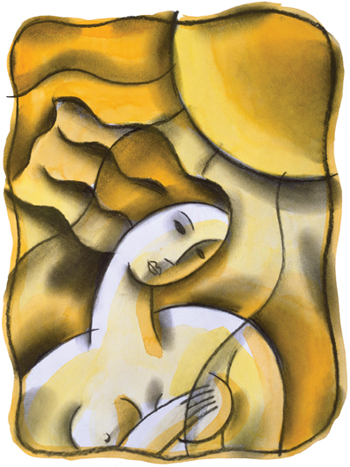Protect Your Breasts

Protect Your Breasts
Dietary changes and regular exercise can help prevent breast cancer.
by Susan Weiner, Energy Times
Roughly 40,170 times a year, or nearly once every 13 minutes, an American woman dies of breast cancer. It is the most common malignancy among women except those affecting the skin. But while most skin cancers are non-lethal, breast cancer is the second leading cause of female cancer deaths.
 The chance of developing invasive breast cancer at some time in a woman’s life is a little less than one in eight, according to the American Cancer Society (ACS). Last year, 62,280 new cases of carcinoma in situ (CIS, the non-invasive, earliest form) and 192,370 new cases of invasive breast cancer were diagnosed in American women. What many people don’t realize is that men aren’t spared. The ACS says that 1,910 new cases of invasive male breast cancer were diagnosed in 2009, with 440 deaths.
The chance of developing invasive breast cancer at some time in a woman’s life is a little less than one in eight, according to the American Cancer Society (ACS). Last year, 62,280 new cases of carcinoma in situ (CIS, the non-invasive, earliest form) and 192,370 new cases of invasive breast cancer were diagnosed in American women. What many people don’t realize is that men aren’t spared. The ACS says that 1,910 new cases of invasive male breast cancer were diagnosed in 2009, with 440 deaths.
Ductal cancer, which affects cells lining the ducts that carry milk to the nipple, is the mostwidespread form. The other primary type, lobular cancer, develops in the milk-producing areas of the breast. These mutated cells can break away and move around the body to form secondary breast cancer.
The likelihood of disease development increases with age, since exposure to risk factors accumulates over time.
The good news is that breast cancer rates decreased by 2% a year between 1999 and 2006 (the last year for which comparative data is available). The ACS attributes this decrease to a drop in the use of synthetic hormone replacement during menopause.
Cancer Triggers
Genetic, environmental and lifestyle factors are all believed to play a role in cancer development. “Alcohol is definitely a key risk for breast cancer, particularly because it increases the levels of estrogen,” says Natalie Ledesma, MS, RD, CSO, oncology dietician with the Cancer Resource Center at the UCSF Helen Diller Family Comprehensive Cancer Center in San Francisco (www.cancer.ucsf.edu). “What you eat and drink modulates the way your genes are expressed and that can influence the tendency to develop cancer.” The link between alcohol and breast cancer has been extensively documented. The Million Women Study, a seven-year British investigation, concluded that as many as 11% of breast cancers can be attributed to alcohol consumption (Journal of the National Cancer Institute 3/4/09).
Common chemicals in the home, garden and workplace act like estrogen in the body, a hormone linked directly to breast cancer. Your body probably contains a chemical called bisphenol A, or BPA, a synthetic estrogen used in everything from plastics to epoxies to the interior coating in many cans. More than 200 studies show links between low doses of BPA and cancer, according to the Breast Cancer Fund (www.breastcancerfund.org), a nonprofit environmental watchdog group.
Overweight women are more susceptible to breast cancer. Risk increases depending on how late in life weight gain occurs, with triple the probability of breast cancer if body mass index is at its maximum after age 50, according to a study in the Journal of Cancer Epidemiology (9/09). The research also found that smoking a pack of cigarettes a day for nine years increased breast cancer odds by 59%.
While having a mother or sister with breast cancer raises risk, only an estimated 5% to 10% of all breast cancers are hereditary. Particular genetic mutations are more common among certain geographic or ethnic groups, including people of Ashkenazi Jewish heritage and individuals of Dutch, Norwegian or Icelandic ancestry. “Most breast cancers are not due to strong hereditary factors,” explains medical geneticist Patricia Kelly, PhD, who has a cancer risk assessment practice in Berkeley, California. Breast cancer development is complex even if genetics isn’t involved; Kelly says that it takes about 15 different changes inside one cell to bring about a non-hereditary malignancy.
“If a woman has a relative diagnosed with breast cancer before age 50, or several relatives on one side of the family with breast, ovarian or other cancers, she may benefit from a visit to a genetic counselor who specializes in cancer risk assessment,” says Kelly, author of Assess Your True Risk of Breast Cancer (Holt). “Testing is available to detect some of the strongly inherited breast cancers.” The genes most commonly linked with cancer are BRCA-1 and BRCA-2; other genes that may play a role in disease development include ATM, P53 and P65.
Some researchers believe that up to one-third of all breast cancer case could be avoided through dietary and other lifestyle changes (Seventh European Breast Cancer Conference, Barcelona, 3/10). But it’s important to remember that while a healthy lifestyle can help reduce one’s risk of cancer, this disorder can affect anyone. Bob Riter first noticed the lump under his left nipple while reading in bed, absent-mindedly scratching his chest. The growth, about the size of a pencil eraser, didn’t alarm him; he simply filed a mental note to discuss the matter with his healthcare provider and fell asleep. Three weeks later, while driving home from work, Riter felt wetness on his chest, looked down and saw blood on his white shirt. His nipple was bleeding.
A biopsy confirmed that Riter had breast cancer. He was 40 years old, in good health, an avid exerciser and had no history of breast cancer in his family. “I knew in theory that men got breast cancer,” says Riter, associate director of the Cancer Resource Center of the Finger Lakes in Ithaca, New York (www.crcfl.net), a nonprofit that helps people deal with the ramifications of cancer diagnosis and treatment. “It was like knowing in theory that you could get hit by an asteroid.”
Detection Toolbox
For a woman, a breast cancer diagnosis can be emotionally devastating. “There are a lot of psychosocial issues around breasts. The disease, in so many ways, is so related to being a woman,” says Eliot Edwards, ND, at Cancer Treatment Centers of America (CTCA) Midwestern Regional Medical Center in Zion, Illinois (www.cancercenter.com/midwestern-hospital.cfm). “It’s potentially a deadly disease and the treatments are invasive.” Finding cancer early can help improve a woman’s chance of saving the affected breast.
Small breast cancers, the most treatable kind, typically produce no symptoms. That makes detection difficult without the proper diagnostic tools. ACS guidelines for early detection include mammography and the clinical breast exam (CBE), in which the practitioner carefully palpitates (feels) the breast. Magnetic resonance imaging (MRI), in which a magnetic field is used to create images of body structures, is also suggested for women at increased breast cancer risk.
During a mammogram, X-rays are used to provide a picture of the breast’s internal structure; its proponents say that mammography can show abnormal tissue changes before they can be found by any other method. In November 2009, the US Preventive Services Task Force released new recommendations suggesting that women begin routine mammogram screenings at age 50, as opposed to age 40, a long-recommended guideline. Additionally, the group advised mammograms every two years, as opposed to annually, and discouraged women from conducting self-breast exams.
While the new recommendations were intended to limit radiation exposure, they instead created debate and uproar in the medical community. To date the American Cancer Society and the National Cancer Institute, along with the American College of Obstetricians and Gynecologists, still recommend yearly mammograms beginning at age 40, in addition to self-breast exams.
“Any exposure to radiation has a potential risk, but mammograms have been an effective tool in identifying cancers,” says Edwards. “Patient risk factors, such as family history, smoking or if they’ve been diagnosed with other cancers, increases the necessity of mammograms. I’m still in the camp that, until we have better methods of detection, that is the method that we have right now.” Research continues into mammography’s usefulness. For example, one Danish study suggests that it may not improve overall cancer survival rates (British Medical Journal 3/24/10 online).
Some practitioners recommend thermography (also known as digital infrared imaging, or DII) as an alternative. This method measures differences in temperature within the breast; it is based on the idea that cancer cells are more metabolically active and require increased blood flow, which makes malignant areas warmer than the surrounding tissue.
Lifestyle Support
To ward off the chances of developing breast cancer, Edwards stresses lifestyle changes that incorporate nutritional support and exercise. “Clearly, anything we do that causes oxidative damage to the body—drinking, smoking, eating trans fats, not exercising—are factors,” he says. “Exercise is the best way to detoxify your body. It will lower body fat and lower estrogen production.”
Women who consume more fiber and less fat have lower levels of estrogen in their bodies. Ledesma advocates a vegetarian-based diet of beans, legumes, whole grains and plant-based foods. “Use animal protein as a condiment as opposed to up to 50% or more of a meal,” she says. “Load up with cancer-fighting phytonutrients to help inactivate carcinogens and nourish and detoxify the body. There’s no real room for processed and fast foods in a healthy, cancer-fighting diet.”
“From a naturopathic perspective, it’s about how well our bodies are metabolizing those estrogens,” explains Edwards. “One of the main things to prevent cancers in general is to support the body in its ability to detoxify.” Cruciferous vegetables such as broccoli and cabbage contain diindolmethane, or DIM, a plant compound (available in supplement form) that helps the body effectively eliminate hormones. Freshly ground flax seed, high in cancer-fighting omega-3 fatty acids, can also aid in estrogen metabolism.
“The two big anti-cancer herbs that we use are green tea extract and curcumin, the principal curcuminoid of the Indian spice turmeric,” says Edwards. Studies show that curcumin can block estrogen-mimicking chemicals from getting into cells, while regular consumption of green tea may reduce a woman’s risk of breast cancer by about 12% (Journal of Nutrition 2/09).
With death rates from breast cancer on the decline, it seems that increased awareness, earlier detection, effective screenings and lifestyle changes are paying off. So eat a healthy, balanced diet rich in vegetables, take long walks, use natural cleaners and get screened. Your breasts will thank you.